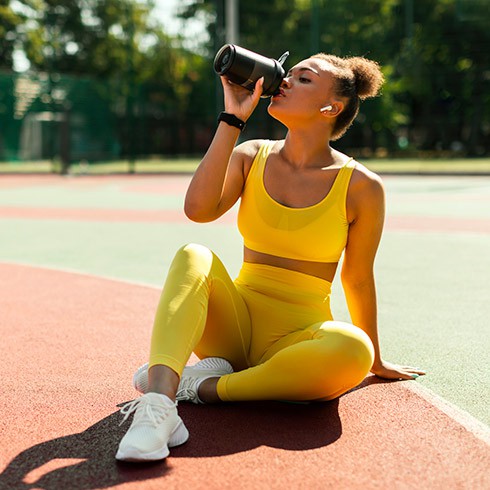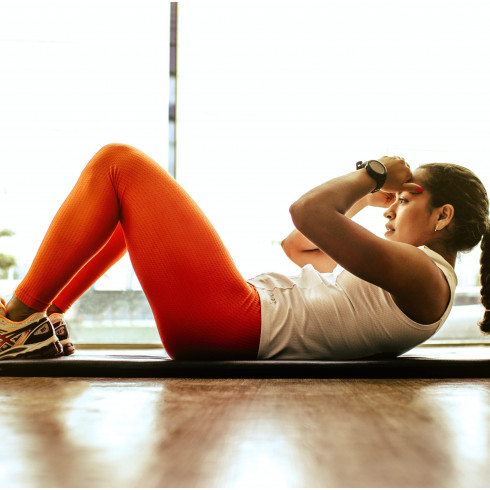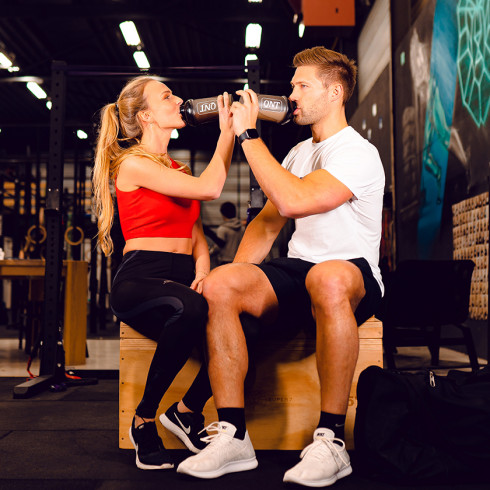The advantages and disadvantages of sports and competitive sports.
The Benefits of Sports.
1. Improvement of Physical Health.
Strengthening the Cardiovascular System.
Regular physical activities such as running, swimming, cycling, or brisk walking help strengthen the heart, which is a muscle like any other. With regular training, the heart becomes more efficient and can pump blood with less effort. Here are some specific benefits :
- Reduction of Cardiovascular Disease Risk: Exercise helps lower blood pressure and improve lipid profiles, thereby decreasing the risks of atherosclerosis and other heart diseases.
- Improvement in Blood Circulation: Exercise promotes the formation of new blood vessels (angiogenesis) and enhances overall circulation, reducing the risk of thrombosis.
- Increase in Lung Capacity: Aerobic exercises boost lung capacity and respiratory efficiency, providing more oxygen to muscles and vital organs.
Weight Loss and Body Mass Control.
Exercise is a key element in weight management and obesity prevention. Here's how :
- Calorie Burning: Any physical activity consumes energy, and the higher the exercise intensity, the more calories are burned. This directly contributes to weight loss.
- Increase in Basal Metabolism: Regular exercise can boost the basal metabolic rate, meaning the body burns more calories at rest.
- Reduction of Body Fat: Exercises combining cardiovascular training and strength training are particularly effective for reducing body fat and increasing muscle mass, which helps with better weight control.
Improvement in Muscle Strength and Flexibility.
Strength training and stretching exercises have significant benefits for muscles and joints :
- Development of Muscle Strength: Resistance exercises, such as weight training, increase muscle size and strength. This not only allows you to lift heavier loads but also helps prevent injuries by strengthening the muscles around the joints.
- Improvement in Flexibility: Stretching exercises and practices like yoga enhance the flexibility of muscles and tendons, reducing the risk of injuries and improving range of motion.
- Improvement in Posture and Balance: A stronger and more flexible body helps maintain better posture and balance, which is crucial for daily activities and fall prevention, especially in older adults.
The benefits of exercise on physical health are numerous and varied, ranging from strengthening the heart to managing weight and improving muscle strength and flexibility. Adopting a regular exercise routine is essential for maintaining and enhancing overall health.
2. Mental Well-being.
Reduction of Stress and Anxiety.
Regular physical activity is one of the most effective ways to reduce stress and anxiety. Here's how :
- Release of Endorphins: Physical exercise stimulates the production of endorphins, which are feel-good hormones that act as natural painkillers and mood regulators.
- Muscle Relaxation: Physical activity helps release accumulated muscle tension, contributing to a general sense of relaxation.
- Positive Distraction: Exercise allows you to focus on a physical activity and divert your mind from daily worries, providing a beneficial form of "mental break."
Improvement in Mood and Reduction of Depression Symptoms.
Exercise plays a key role in improving mood and combating depression. Here are the mechanisms involved :
- Increase in Positive Neurotransmitters: Exercise boosts levels of neurotransmitters such as serotonin and dopamine, which are often low in people with depression.
- Reduction of Inflammation: Regular physical activity helps reduce bodily inflammation, a factor often associated with depression.
- Routine and Consistency: Establishing a regular exercise routine can provide a structured framework and a sense of purpose, which is beneficial for individuals suffering from depression.
Increase in Self-Esteem and Self-Confidence.
Exercise can significantly improve self-esteem and self-confidence through the following elements :
- Achievement of Personal Goals: Setting and achieving fitness goals, whether small or large, boosts self-confidence and a sense of accomplishment.
- Improvement in Body Image: Regular physical activity can enhance the perception of one's own body, increasing body satisfaction and confidence in physical appearance.
- Skill Development: Mastering new skills and improving athletic performance reinforce feelings of competence and self-efficacy.
In summary, the benefits of exercise on mental well-being are significant. By reducing stress and anxiety, improving mood, and boosting self-esteem, exercise contributes to better mental health and a more fulfilling life. Incorporating regular physical activity into your daily routine is essential to experiencing these positive effects on mental well-being.
3. Socialization.
Opportunities to Meet New People and Make Friends.
Engaging in sports provides many opportunities to socialize and form new friendships. Here's how :
- Joining Clubs and Teams: Whether in sports clubs, amateur teams, or group classes, sports bring together people with common interests, making it easier to meet and interact with others.
- Events and Competitions: Sports events, competitions, and tournaments are ideal opportunities to meet fellow enthusiasts, share experiences, and build new relationships.
- Group Workouts: Group training sessions, such as running groups, yoga classes, or fitness classes, allow you to connect with people who share similar goals and interests.
Development of Social Skills and Teamwork.
Sport is an excellent way to develop social skills and learn teamwork. Here are a few examples :
- Communication: Participating in team sports requires effective communication to devise strategies, give instructions, and encourage teammates.
- Cooperation and Collaboration: The success of a team depends on the members' ability to collaborate, share responsibilities, and work together toward a common goal.
- Conflict Management: Sports teach how to handle conflicts constructively by finding solutions and learning to accept differences.
Strengthening Community Ties.
Sport plays an important role in strengthening community ties and promoting social cohesion. Here's how :
- Community Participation: Local sports events, such as charity runs, tournaments, and sports festivals, encourage community involvement and strengthen social ties.
- Volunteering and Support: Sports clubs and organizations offer numerous volunteering opportunities, allowing individuals to contribute to their community and feel valued.
- Social Integration: Sport promotes social inclusion by bringing together people from different backgrounds, cultures, and ages, creating a sense of belonging and unity.
Sport is therefore a powerful vehicle for socialization. It offers unique opportunities to meet new people, develop social skills, and strengthen community ties. By actively participating in sports activities, you can not only improve your physical condition but also enrich your social life and contribute to the well-being of your community.
4. Improvement in Quality of Life.
Better Sleep.
Exercise has a significant impact on sleep quality, contributing to deeper and more restorative rest. Here's how :
- Regulation of the Sleep-Wake Cycle: Physical exercise helps synchronize the body's internal clock, making it easier to fall asleep and improving sleep regularity.
- Reduction of Insomnia: Regular physical activity reduces symptoms of insomnia by decreasing the time it takes to fall asleep and increasing the overall duration of sleep.
- Improvement in Deep Sleep Quality: Physical activity, especially aerobic exercises, increases the amount of time spent in deep sleep, the most restorative phase of the sleep cycle.
Increased Energy and Vitality.
Engaging in regular physical activity boosts energy and vitality on a daily basis. Here’s why :
- Improvement in Blood Circulation: Exercise increases blood flow, delivering more oxygen and nutrients to muscles and organs, which translates into better overall energy.
- Production of Mitochondria: Physical training stimulates the production of mitochondria in muscle cells, enhancing the body's ability to produce energy.
- Reduction of Fatigue: Active individuals often report decreased daily fatigue and a heightened sense of overall well-being.
Increased Life Expectancy.
Exercise contributes to a longer and healthier life. Here’s how :
- Prevention of Chronic Diseases: Regular exercise reduces the risk of chronic diseases such as cardiovascular conditions, type 2 diabetes, certain cancers, and osteoporosis.
- Strengthening the Immune System: Moderate physical activity boosts the immune system, helping the body fend off infections and illnesses.
- Maintaining Mobility and Independence: As we age, exercise helps preserve muscle strength, bone density, and flexibility, which are essential for maintaining an active and independent life.
In summary, the benefits of exercise on quality of life are undeniable. By improving sleep, increasing energy, and extending life expectancy, regular physical activity contributes to a healthier and more fulfilling lifestyle. Incorporating exercise into daily life is therefore essential for better long-term quality of life.
5. Personal Development.
Developing Discipline and Perseverance.
Engaging in sports is an excellent way to develop essential skills such as discipline and perseverance. Here’s how :
- Consistency in Training: Committing to a regular training routine requires discipline, which helps establish positive habits and maintain a constant commitment to both athletic and personal goals.
- Overcoming Challenges: Sports often present physical and mental challenges. Learning to overcome these obstacles develops perseverance, a crucial trait for success in many areas of life.
- Adherence to Rules and Structures: Engaging in sports involves following rules, schedules, and structures, thereby enhancing the ability to adhere to guidelines and function effectively in structured environments.
Time and Priority Management.
Sports teach valuable skills in time management and prioritization. Here’s how :
- Balancing Sports and Other Responsibilities: Athletes often need to juggle training, studies, work, and personal life. This necessity to balance various aspects of life promotes effective time management.
- Planning and Organization: Success in sports often requires planning training sessions, competitions, and rest periods. This habit of planning can be applied to other areas of life as well.
- Prioritizing Goals: Sports help in identifying and prioritizing short- and long-term goals, teaching individuals to focus on what is most important and manage distractions.
Sense of Achievement and Goal Attainment.
Engaging in sports provides a deep sense of accomplishment and satisfaction from achieving goals. Here’s how :
- Setting and Achieving Goals: Athletes set specific, measurable, and attainable goals, and work diligently to achieve them. This builds self-confidence and a sense of competence.
- Recognizing Progress: By tracking improvements over time, athletes can see tangible enhancements in their performance, which strengthens motivation and a sense of accomplishment.
- Celebrating Successes: Reaching significant milestones in sports, such as completing a race or winning a match, provides immense satisfaction and reinforces the desire to continue setting new challenges.
In summary, personal development through sports encompasses learning discipline and perseverance, time and priority management, as well as a sense of achievement and goal attainment. These skills and experiences gained on the field translate into lasting benefits in many aspects of daily life, contributing to personal growth and overall success.
The Negative Aspects of Competitive Sports.
1. Risk of Injuries.
Acute Injuries (Sprains, Fractures, Muscle Tears).
Competitive athletes are at high risk for acute injuries, which can occur suddenly and require immediate medical attention. Here are some common types of acute injuries :
- Sprains: Sprains occur when the ligaments supporting the joints are stretched or torn, often due to sudden movements or abnormal twisting. This can lead to intense pain, swelling, and temporary inability to use the affected joint.
- Fractures: Bone fractures result from violent impacts or excessive pressure, such as falls or collisions. They can vary in severity, from minor cracks to complete breaks requiring surgical intervention.
- Muscle Tears: Muscle tears, or strains, occur when muscle fibers are excessively stretched or torn, often due to rapid movements or overloads. Symptoms include sudden pain, swelling, and weakness in the affected muscle.
Chronic Injuries (Tendinitis, Cartilage Damage).
Competitive sport can also lead to chronic injuries, resulting from repetitive movements and persistent overload on certain body parts. Here are some common examples of chronic injuries :
- Tendinitis: Tendinitis is an inflammation of the tendons caused by excessive use. Athletes can develop tendinitis in the shoulders, elbows, knees, or ankles, leading to pain and restricted movement.
- Cartilage Damage: Articular cartilage can wear down or deteriorate due to repetitive movements and constant impact, leading to conditions like osteoarthritis. Cartilage damage is often irreversible and can cause chronic joint pain.
- Overuse Syndromes: These injuries occur when specific tissues, such as muscles, tendons, or ligaments, are subjected to repeated stress without adequate rest. Examples include iliotibial band syndrome and carpal tunnel syndrome.
Overtraining and exhaustion.
Overtraining is a condition resulting from excessive exercise without adequate recovery, leading to decreased performance and various health problems. Here are some consequences of overtraining and exhaustion :
- Persistent Fatigue: Overtraining leads to chronic fatigue, decreased energy, and an inability to fully recover from workouts.
- Decreased Performance: Overtrained athletes often experience a drop in performance, reduced strength and endurance, and slower recovery after exertion.
- Mental Health Issues: Overtraining can also impact mental health, causing symptoms such as irritability, depression, anxiety, and a loss of motivation.
- Weakened Immune System: Excessive training without adequate rest can weaken the immune system, making athletes more susceptible to infections and illnesses.
Competitive sports carry significant risks of acute and chronic injuries, as well as overtraining and burnout. It is essential for athletes to follow balanced training protocols, get adequate rest, and receive appropriate medical care to minimize these risks and sustain a long-lasting sports career.
2. Stress and Pressure.
Psychological Pressure for Performance.
Competitive athletes often experience intense psychological pressure to achieve high performance. Here’s how this pressure manifests :
- High Expectations: High expectations from coaches, sponsors, supporters, and sometimes family can create an environment where athletes feel constantly pressured to perform at their best.
- Aspiring Goals: Setting ambitious and sometimes unrealistic goals can add extra pressure. Athletes may feel the need to break records, win competitions, or achieve exceptional results at every event.
- Severe Self-Criticism: The pursuit of perfection and fear of failure can lead to severe self-criticism, affecting self-confidence and increasing stress.
Competition and Results-Related Anxiety.
Intense competition and the desire to succeed can generate significant anxiety in athletes. Here’s how :
- Fear of Failure: The fear of not succeeding or disappointing others can cause intense anxiety, affecting athletes' performance and mental health.
- Anticipation of Competitions: Anticipating important competitions can lead to high levels of anxiety, with symptoms such as sleep disturbances, heart palpitations, and difficulties in concentration.
- Constant Pressure to Deliver Results: The constant need to prove one's worth through competitive results can create chronic stress, undermining the joy of the sport and emotional balance.
Risk of Sports Burnout.
Sports burnout is a state of physical and mental exhaustion resulting from constant pressure and stress related to competition. Here are the signs and consequences of burnout :
- Extreme Fatigue: Athletes experiencing burnout feel extreme fatigue that does not go away with rest. This includes physical exhaustion and mental weariness.
- Loss of Motivation: The passion for the sport diminishes, and athletes may lose the desire to train or compete. This lack of motivation can be devastating to their sports career.
- Decline in Performance: Burnout often leads to a decrease in performance, with athletes unable to return to their usual level of play.
- Mental Health Issues: Burnout can cause symptoms of depression, anxiety, and mood disorders, severely affecting athletes' mental well-being.
Stress and pressure in competitive sports are significant factors that can have harmful effects on athletes' mental and physical health. Psychological pressure for performance, competition and results-related anxiety, as well as the risk of sports burnout, are realities that must be managed with care. It is crucial for athletes, coaches, and sports organizations to implement mental support strategies and stress management programs to protect athletes' well-being.
3. Impact on Mental Health.
Depression Related to Failure or Injury.
Failures and injuries can have a profound impact on athletes' mental health. Here’s how :
- Feeling of Failure: Failing to meet goals or perform in competitions can lead to feelings of worthlessness and despair, sometimes resulting in depression.
- Isolation: Injuries can force athletes to step away from their team, training, and competitions, leading to feelings of isolation and loneliness.
- Loss of Identity: Athletes often define their identity through their sports performance. A serious injury or a series of failures can lead to an identity crisis, increasing the risk of depression.
Eating Disorders in Some Athletes.
Competitive sports can contribute to the development of eating disorders. Here are some aspects :
- Pressure to Maintain a Specific Weight: In some sports, there is immense pressure to maintain a low body weight or a certain body composition, which can lead to disordered eating behaviors.
- Extreme Diets: Restrictive diets and extreme eating behaviors to lose or maintain weight can lead to disorders such as anorexia, bulimia, or other unspecified eating disorders.
- Body Image Influence: Beauty and performance standards can cause athletes to develop a distorted perception of their bodies, contributing to eating disorders.
Loss of Balance Between Athletic Life and Personal Life.
An intensive sports career can lead to an imbalance between athletic life and personal life. Here’s how :
- Time Dedicated to Training: Long hours of training and competition leave little time for social activities, hobbies, and personal relationships, which can lead to a sense of imbalance.
- Personal Sacrifices: Athletes often have to make personal sacrifices, such as putting their education or career aspirations on hold, which can lead to regrets and long-term dissatisfaction.
- Relational Stress: The time and energy devoted to sports can affect relationships with family, friends, and partners, leading to conflicts and tensions.
Competitive sports can thus have significant impacts on athletes' mental health. Depression related to failure or injury, eating disorders, and the loss of balance between athletic and personal life are common challenges. It is crucial to provide appropriate psychological support and promote mental well-being practices to help athletes navigate these challenges and maintain positive mental health.
4. Social Issues.
Social Isolation Due to Intense Training.
The intense training required to reach high levels of competition can lead to social isolation. Here’s how :
- Limited Time for Social Interactions: Long hours of training, competitions, and travel leave little time for social activities and meeting with friends.
- Disconnection from Peers: Athletes may feel disconnected from their peers who do not share the same lifestyle or schedule, creating a social gap.
- Focus on Sports Goals: The focus on sports goals can lead athletes to neglect their social relationships, resulting in feelings of isolation and loneliness.
Relationship Issues with Loved Ones.
The demands of competitive sports can affect relationships with loved ones in various ways :
- Time Conflicts: Sports commitments can conflict with family events and social obligations, creating tension and misunderstandings with loved ones.
- Stress and Pressure: The pressure to perform and frustrations related to competitions can spill over into personal relationships, leading to disputes and conflicts.
- Lack of Support: Loved ones may not always understand the sacrifices and commitments required to excel in sports, which can result in a lack of emotional support and feelings of isolation.
Conflicts of Interest Between Sports and Studies/Work.
Competitive athletes often have to balance their sports career with academic or professional obligations, which can lead to conflicts of interest. Here’s how :
- Time Dedicated to Training vs. Studies/Work: The demands of sports can interfere with school or work schedules, making it difficult to balance both areas.
- Conflicting Priorities: Athletes may find themselves torn between the need to perform in their sport and their academic or professional aspirations, creating stress and personal dilemmas.
- Sacrificed Opportunities: Athletes may have to forgo important educational or professional opportunities due to their sports commitments, which can affect their future career and personal development.
In conclusion, competitive sports can lead to various social issues, such as social isolation due to intense training, relationship problems with loved ones, and conflicts of interest between sports and studies or work. It is essential for athletes to find a healthy balance between their sports life and personal life to maintain strong relationships and overall well-being.
5. Long-Term Consequences.
Premature Joint Wear.
Intensive and prolonged participation in competitive sports can lead to premature joint wear. Here’s how :
- Cartilage Degradation: Repetitive movements and constant impacts on the joints can lead to progressive cartilage degradation, resulting in conditions like osteoarthritis.
- Chronic Inflammation: Excessive loads and intense movements can cause persistent joint inflammation, leading to pain and reduced mobility.
- Increased Risk of Injuries: Weakened and worn joints are more prone to severe injuries, such as ligament tears or fractures, which may require surgical intervention and extended rehabilitation.
Impact on Post-Sport Career.
Competitive athletes may face several challenges when transitioning to a post-sport career. Here are some aspects :
- Career Transition: Moving from a sports career to another profession can be challenging, requiring adaptation to new routines, work environments, and professional cultures.
- Training and Skills: Skills developed in sports are not always directly transferable to other professional fields, often necessitating additional training or career retraining.
- Professional Satisfaction: Athletes may experience frustration or a loss of satisfaction in jobs that do not provide the same level of adrenaline, recognition, or accomplishment as competitive sports.
Persistent Health Issues After Retirement from Sports.
The physical effects of years of competition can persist long after the end of an athletic career. Here are some examples :
- Chronic Pain: Injuries sustained during the sports career can lead to chronic pain, limiting the ability to lead an active life and affecting overall quality of life.
- Functional Limitations: Former athletes may experience functional limitations, such as restricted movement or muscle weakness, requiring ongoing physical therapy or lifestyle adaptations.
- Mental Health Issues: The transition out of sports can also impact mental health, with increased risks of depression, anxiety, and mood disorders related to loss of identity and challenges in social and professional reintegration.
The long-term consequences of competitive sports include premature joint wear, impact on post-sport careers, and persistent health issues after retirement. It is crucial to consider these risks and plan management and prevention strategies to ensure a smooth transition and optimal quality of life after the sports career.
The Benefits of Competitive Sports.
Improvement in Physical Performance.
Competitive sports drive athletes to achieve their highest level of physical fitness. Here’s how :
- Optimal Physical Condition: Intensive training helps achieve exceptional physical condition, with notable improvements in endurance, strength, and flexibility.
- Development of Specific Skills: Athletes refine technical and tactical skills specific to their sport, enhancing their expertise and mastery.
- Resilience and Recovery: Athletes learn to manage and recover quickly from intense efforts, increasing their ability to perform under pressure.
Mental and Emotional Development.
Competitive sports offer numerous benefits for mental and emotional development. Here are a few examples :
- Stress Management: Frequent competitions teach athletes to manage stress and anxiety effectively, developing mental resilience skills.
- Focus and Discipline: The need to stay focused and disciplined in training and competitions enhances concentration and perseverance.
- Self-Esteem and Confidence: Success in competitive sports boosts self-esteem and confidence in one's abilities, thanks to the recognition of efforts and achievements.
Social and Community Opportunities.
Competitive sports promote socialization and strengthen community bonds. Here’s how :
- Team Spirit: Team sports teach cooperation, communication, and group work, strengthening social relationships and camaraderie.
- Social Networks: Participating in competitions allows athletes to meet other athletes, coaches, and supporters, thereby expanding their social network and opportunities for mutual support.
- Community Engagement: Competitive athletes are often role models for their community, inspiring and motivating others to pursue their own sports goals.
Acquisition of Life Skills.
Competitive sports develop valuable skills that are transferable to other areas of life. Here are a few examples :
- Time Management: Athletes learn to balance training, competitions, studies, and personal life, developing time management and organizational skills.
- Goals and Planning: Setting and achieving sports goals teaches the importance of strategic planning and pursuing long-term objectives.
- Resilience Development: Facing challenges, setbacks, and successes in sports builds resilience and the ability to bounce back from life’s difficulties.
Recognition and Personal Fulfillment.
Competitive sports offer opportunities for recognition and personal fulfillment. Here’s how :
- Success and Awards: Competitive athletes can receive medals, trophies, and other forms of recognition for their achievements, which enhances their sense of accomplishment.
- Personal Pride: The ability to overcome challenges and achieve ambitious goals provides immense personal satisfaction and a sense of pride.
- Positive Influence: Athletes can use their success to make a positive impact, inspiring and motivating others to pursue their own sports and personal dreams.
Competitive sports offer a multitude of benefits, both physically and mentally, socially, and personally. They enhance physical performance, develop mental and emotional skills, promote socialization, teach valuable life skills, and provide a sense of recognition and personal achievement. Incorporating these elements into sports practice can enrich athletes' lives and prepare them to succeed in various aspects of their existence.
Preventing the Demanding Aspects of Competitive Sports.
Injury Prevention.
1. Warm-Up and Stretching :
- Perform a thorough warm-up before each training session to prepare the muscles and joints.
- Include dynamic stretches before training and static stretches afterward to improve flexibility.
2. Balanced Training :
- Vary the types of exercises to avoid overuse of specific body parts.
- Incorporate strength training exercises to support the joints and prevent injuries.
3. Use of Appropriate Equipment :
- Use footwear and protective equipment suitable for the specific sport.
- Regularly replace worn or damaged equipment to ensure optimal protection.
4. Rest and Recovery :
- Schedule regular rest days to allow the body to recover.
- Use active recovery techniques, such as massage and cold baths, to speed up muscle recovery.
Stress and Pressure Management.
1. Relaxation Techniques :
- Learn and practice relaxation techniques, such as deep breathing, meditation, or yoga, to manage stress.
- Incorporate relaxation periods into your daily routine to prevent mental exhaustion.
2. Setting Realistic Goals :
- Set short-term and long-term goals that are Specific, Measurable, Achievable, Realistic, and Time-bound (SMART).
- Recognize and celebrate small successes to maintain motivation and self-confidence.
3. Psychological Support :
- Consult a sports psychologist or counselor for help in managing stress and the pressures of competition.
- Join support groups or talk with other athletes to share experiences and stress management strategies.
Maintaining mental health.
1. Balancing sports and personal life :
- Define clear boundaries between time dedicated to sports and time for leisure, family, and friends.
- Plan social activities and leisure time to maintain a healthy balance.
2. Monitoring Signs of Eating Disorders :
- Be alert to signs of eating disorders and seek professional help if needed.
- Promote a balanced and healthy diet, avoiding extreme diets.
3. Managing Transitions :
- Prepare for the transition to life after a sports career by planning alternative career options and pursuing further education or training.
- Develop interests and skills outside of sports to ensure a smooth transition.
Maintaining Social Relationships.
1. Open Communication :
- Maintain open and honest communication with loved ones to manage expectations and sacrifices related to competitive sports.
- Regularly plan quality time with family and friends to strengthen relationships.
2. Social Support :
- Surround yourself with understanding and supportive people who can offer emotional and moral support.
- Engage in social and community activities to expand your support network.
Nutrition and Hydration
1. Nutritional Planning :
- Work with a sports nutritionist to develop a nutrition plan tailored to individual needs and the specific demands of the sport practiced.
- Ensure a balanced diet rich in macronutrients (proteins, carbohydrates, fats) and micronutrients (vitamins, minerals).
2. Adequate Hydration :
- Maintain optimal hydration by drinking water regularly throughout the day and consuming electrolyte drinks during and after intense workouts.
- Monitor signs of dehydration, such as intense thirst and dry mouth, and adjust fluid intake accordingly.
3. Pre- and Post-Exercise Nutrition :
- Consume complex carbohydrates before exercise to provide sustained energy and prevent performance dips.
- Prioritize foods rich in proteins and fast-digesting carbohydrates after exercise.
To avoid the demanding aspects of competitive sports, it is essential to implement prevention and management strategies including warm-up and recovery, stress management, maintaining mental health, and preserving social relationships. By adopting these practices, athletes can maximize the benefits of competition while minimizing risks and negative impacts.
Coach's Tips.

- Everyone can choose whether they want to compete in any sport, but it is important to understand the consequences and to accept them.
- Not everyone can become a champion in a sport. It requires the right genetics or talent, as well as support from a young age.
- Nutrition is crucial for performance. A balanced diet is very important. Supplementation with vitamins, proteins, and possibly other supplements specific to your sport will be necessary.
- After many years in the sports world, I believe that sports are extremely beneficial for health and provide a definite advantage for staying healthy. However, as in all areas, balance is key to well-being. Competitive sports seem to have more health drawbacks than benefits if not done with the guidance of an informed support team.
- Always take the time to recover from injuries, and especially stop before a minor injury becomes a major problem. When younger, our ego pushes us to ignore injuries and continue training while sick or hurt. This is not a good idea. Allowing your body time to recover is the best way to keep it in shape for as long as possible and to maintain peak performance.
- To be effective, a competitive athlete must be considered holistically. That’s why a significant support team surrounds top athletes today, capable of assisting in every aspect of their needs: psychologist, physiotherapist, masseur, physical trainer, nutritionist, doctor, etc.
Related posts
-
 Summer holidays: How to limit the damage?
Posted in: Our tips24/06/2021On holiday, we often tend to let ourselves go. Unless you're a hardcore sportsman, you tend to abandon your trainers...Read more
Summer holidays: How to limit the damage?
Posted in: Our tips24/06/2021On holiday, we often tend to let ourselves go. Unless you're a hardcore sportsman, you tend to abandon your trainers...Read more -
 Which fat burner to choose?
Posted in: Our tips26/05/2021To lose weight and burn fat, there is no secret: you have to do sport and take care of your diet. However, it is...Read more
Which fat burner to choose?
Posted in: Our tips26/05/2021To lose weight and burn fat, there is no secret: you have to do sport and take care of your diet. However, it is...Read more -
 Summer body edition for men: How to prepare your body?
Posted in: Our tips11/05/2021Gentlemen ? The return of the sun and its warm rays are almost here! The degrees are slowly but surely rising, but...Read more
Summer body edition for men: How to prepare your body?
Posted in: Our tips11/05/2021Gentlemen ? The return of the sun and its warm rays are almost here! The degrees are slowly but surely rising, but...Read more -
 9 good reasons to do sport.
Posted in: Our tips22/04/2021Sometimes the urge to exercise is not always there. And although we always tell ourselves that this year will finally...Read more
9 good reasons to do sport.
Posted in: Our tips22/04/2021Sometimes the urge to exercise is not always there. And although we always tell ourselves that this year will finally...Read more -
 Discover how to take care of your faithful companion: your shaker!
Posted in: Our tips07/04/2021In your bag, in your hand, in your sink, it is everywhere! The shaker is an essential element of any good training....Read more
Discover how to take care of your faithful companion: your shaker!
Posted in: Our tips07/04/2021In your bag, in your hand, in your sink, it is everywhere! The shaker is an essential element of any good training....Read more
Blog categories
Popular posts
-
 Looking thinner but at a heavier weight? Is that possible?04/10/2021Posted in: Our tipsAdvertising has shaped our thinking! We have been forced for years to believe that losing weight is the key to having...Read more
Looking thinner but at a heavier weight? Is that possible?04/10/2021Posted in: Our tipsAdvertising has shaped our thinking! We have been forced for years to believe that losing weight is the key to having...Read more -
 Proteins for weight loss !29/12/2023Posted in: Our tipsDive into the fascinating world of proteins and their key role in weight loss. Discover how to choose the best...Read more
Proteins for weight loss !29/12/2023Posted in: Our tipsDive into the fascinating world of proteins and their key role in weight loss. Discover how to choose the best...Read more -
 Which foods boost testosterone levels ?07/05/2021Posted in: Food supplementsTestosterone, often associated with virility, has much more to offer than you might think. It plays a crucial role in...Read more
Which foods boost testosterone levels ?07/05/2021Posted in: Food supplementsTestosterone, often associated with virility, has much more to offer than you might think. It plays a crucial role in...Read more -
 Is there a link between sex and sport?14/11/2019Posted in: LifestyleMany have already asked questions about sex and sport. Most of the time, people want to be reassured by the many...Read more
Is there a link between sex and sport?14/11/2019Posted in: LifestyleMany have already asked questions about sex and sport. Most of the time, people want to be reassured by the many...Read more -
 10 BENEFITS OF GLUTAMINE.02/01/2024Posted in: Our tipsDiscover the power of L-glutamine, an underrated superhero in the world of amino acids! Essential for revitalizing...Read more
10 BENEFITS OF GLUTAMINE.02/01/2024Posted in: Our tipsDiscover the power of L-glutamine, an underrated superhero in the world of amino acids! Essential for revitalizing...Read more

.jpg)

